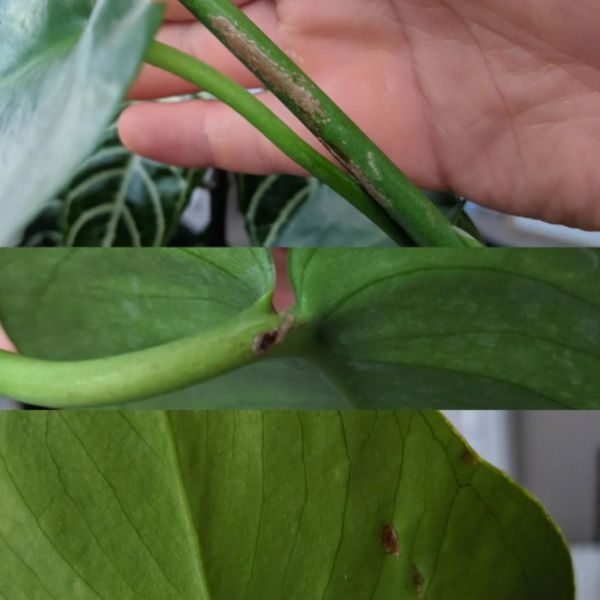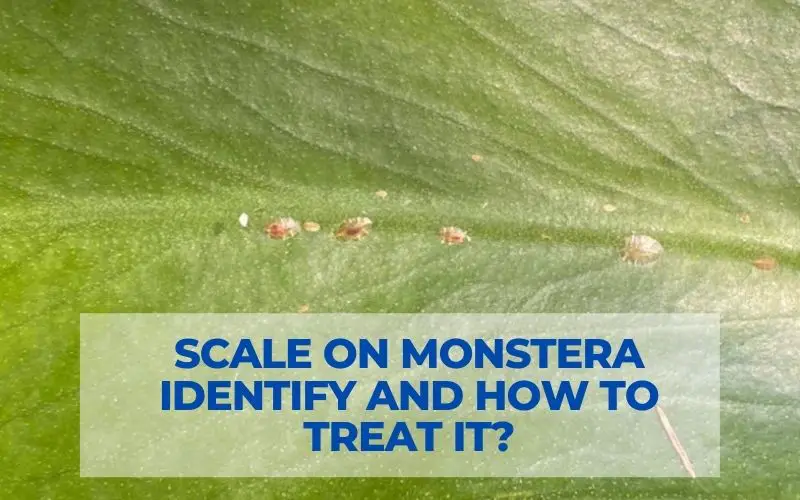While most monstera plants are low-maintenance and easy to care for, they are subject to pest infestations from home pests! Scale, a sort of bug that can adhere to your monstera and suck the juices out of the leaves and stems, is one possible invader. A heavy-scale infestation can eventually kill your Monstera if left untreated. DIG NURSERY will show you how to identify and treat the scale on Monstera plants in this article so you can get your plant back to full health.
How to Identify Scale on Monstera Deliciosa?
Most Scales on Monstera species are soft insects with a tough outer shell (except for mealybugs, which have soft bodies and no shell). Scale attaches to the leaves, stems, and trunks of plants and suckers the sap out of them while hiding under the shell’s protection. This can make them difficult to remove, but not impossible!
It’s worth noting that these insects prefer humidity and warmth. As a result, they will expect them to be outside during the spring and summer. They can be found indoors at any time.

Armored scales
Armored scales are smaller (1/16 to 1/8 inch long) and have a shell-like cover that they conceal. They are a variety of colors, and shapes (circular, elongated, or elliptical), and appear flattened, rather than raised or brumby.
Their legs and antennae are invisible, and their bodies are either yellow or orange beneath the shell. They are commonly found stationary on lower leaf surfaces and may appear as spots. They can be found on stems, leaf joints, or any other hidden area, and they do not move, i.e., they are stationary.
But that’s not all. Except for orchids, armored scales are not a common problem in houseplants. As a result, they are frequently overlooked. Finally, among the armored scales are Oystershell, Euonymus, Pine Needle, and San Jose scale.
Soft scale
Soft scales are slightly larger than hard scales, oval to round in shape, and raised, bumpy, or dome-shaped. Their bodies, unlike armored scales, lack a shell-like covering. Instead, they have waxy secretions that make their bodies fluffy.
Most are shaped like tiny tortoise shells and come in a variety of colors. However, when they are immature, they appear a little light. They darken as they mature. Again, unlike armored scales, they do not completely lose their legs or antennae. They are, however, reduced. While they can move, most adults do not.
The most common scales you’ll see on your Monstera are soft, soft brown scales. On the other hand, others attack plants such as cottony maple, European elm, Fletcher, hemispherical, Lecanium, and magnolia scale. Their names will give you an idea of which plants they prey on.
Scale lifecycle
The majority of scale insects appear as small brown bumps attached to your plant, but they can also be brown, cream-colored, or black. The majority of scales are about 1/8 inch in diameter and can be round or oval in shape. Basically, if you notice some strange bumps on your plant that you can easily pry off with your fingernails, you may have scale.
Scale can attach to the tops and bottoms of Monstera leaves, as well as the stems. When you water your Monstera plant, give it a once-over to check for signs of insect infestations or other health issues. Examine the stems and the tops and bottoms of the leaves.
Monstera signs and damage scale
Soft scales, particularly hemispherical and brown scales, are most common in Monstera and most indoor plants. They suck plant juices with their mouthparts. This causes cell tissue damage. Toxins may even be injected by some.

The symptoms will vary depending on the severity of the infestation. Some examples, including damage, are:
- The mold that is smoky
- Leaves with yellow mottling
- Leaves wilting
- Falling leaves
- Growth has been slowed.
How to Treat Scale on Monstera?
Since Scale on Monstera attaches so firmly to plant leaves and stems, they can be challenging to remove. Getting them all can be time-consuming, but saving your Monstera is worth it!
Getting Rid of Monstera scale
Scale cannot be removed by rinsing or spraying off Monstera. Instead, these insects must be removed manually, either by prying them off or by getting them to detach on their own.
You can remove a lot of the scale with your fingernails or a soft brush, but keep in mind that some insects are stubborn and may require more force. Also, avoid picking or brushing off the scales and accidentally dropping them into the soil or on another part of the plant. They’ll simply reattach or even lay eggs, and you’ll be back in the same situation!
You can rinse the plant after picking off the scale to help remove any stragglers, but make sure to tip the plant on its side to avoid washing the scale on Monstera into the soil or over-soaking the potting mix.
Using a cotton swab, remove all visible traces of scale
One method for removing the scale is to soak a cotton swab in rubbing alcohol and then rub the swab over the scale. This should help eliminate some of the more clingy insects, but be careful not to get too much alcohol directly on the plant.
With larger infestations, prune out the leaves and stems
If scales have entirely taken over some of your Monstera’s leaves or branches, it may be easier to simply prune them off.
Using soap and hot water or rubbing alcohol to sterilize some sharp pruning shears, carefully snip off the overgrown leaves or stem, taking care not to knock any scale into the soil or onto another part of the plant.
Scale can be killed with insecticide or rubbing alcohol
If you can’t get all of the scales off and the infestation is severe, or if the scale keeps coming back, you should use an insecticide or rubbing alcohol on a cotton swab to remove them.
Of course, if you’re using an insecticide, follow the directions on the bottle, which will most likely include spraying the entire plant and wiping off the leaves to remove excess soap. Wrap the pot and soil in plastic to avoid soaking the soil or getting a lot of insecticide into the potting mix.
Tip: Because insecticides can make plants more photosensitive and prone to leaf scorch, apply them in the evening. You should also move the plant away from the window for a few days.
An insecticide is especially effective for recurring infestations because it removes both eggs and scale insects.
Read More: How to get rid of Thrips on Monstera: Signs, Control & Remove
How Do You Naturally Prevent Scale?
Scale on Monstera is challenging to treat, and even if you catch and treat it early, it can take time for your Monstera to recover from an infestation. Natural prevention is unquestionably the best option!
Ladybugs should be introduced
Introduce natural predators, such as ladybugs, to your plant as a natural (and fun!) way to prevent insect problems.

This isn’t always a popular choice for indoor plants, but having ladybugs around can be entertaining (especially if you have kids!) and they’re very effective at preventing pests. If your Monstera is in a room with other plants, such as a sunroom or covered porch, where helpful insects will not be a nuisance, this could be a great solution!
You can easily order ladybugs online and simply release them into the soil of your Monstera. They’ll take care of themselves, and your pest issues may disappear!
Insecticide Made at Home
If you don’t want to use a commercial insecticide, a simple mixture of detergent-free soap and water can work wonders!
Combine a teaspoon of mild, detergent-free dish soap with 4 cups of water in a spray bottle, and spray down your Monstera. Wipe away the excess to reveal clean, shiny, insect-free leaves!
Vinegar spray is also effective and simple to make. Combine one cup of plain white vinegar with three cups of water and a few drops of mild dish soap. As usual, spray and wipe your plant!
It’s also a good idea to spray down all of your plants if one of them becomes infested with insects, or at least the plants closest to the infected plant. This can keep insects from spreading and laying eggs from plant to plant!
Use Neem Oil
Neem oil is another well-known and highly effective treatment for insect infestations. Follow the dilution instructions on the bottle and spray down your plant as you would an insecticide, then wipe off the excess with a soft cloth to get rid of or even prevent a scale takeover.
Tip: Because neem oil has a strange odor, it’s best to do this outside if possible. It’s also a good idea to use old, unappealing cloth!
New Plants Must Be Quarantined
Another critical, but often overlooked, aspect of pest prevention is keeping new plants separate from your existing plants until any latent infestations manifest so you can deal with them.
When you bring a new plant home, try to keep it separate from other plants for a week or two and keep an eye on it. If you notice any insect problems, treat them immediately and make sure the problem is resolved before placing the plant near your other plants.
Inspect the plant before bringing it home (as you would if you were buying it at a nursery rather than online), looking for signs of insects such as bumps, webbing, or sticky residue. If you notice any of these signs, you should reconsider your purchase!
Fighting insects is a necessary part of plant ownership, and you may have to go to war from time to time. However, if you pay attention to your Monstera plant and treat problems as soon as you notice them, you should have no trouble eliminating scale on Monstera before they cause permanent damage to your plant.


